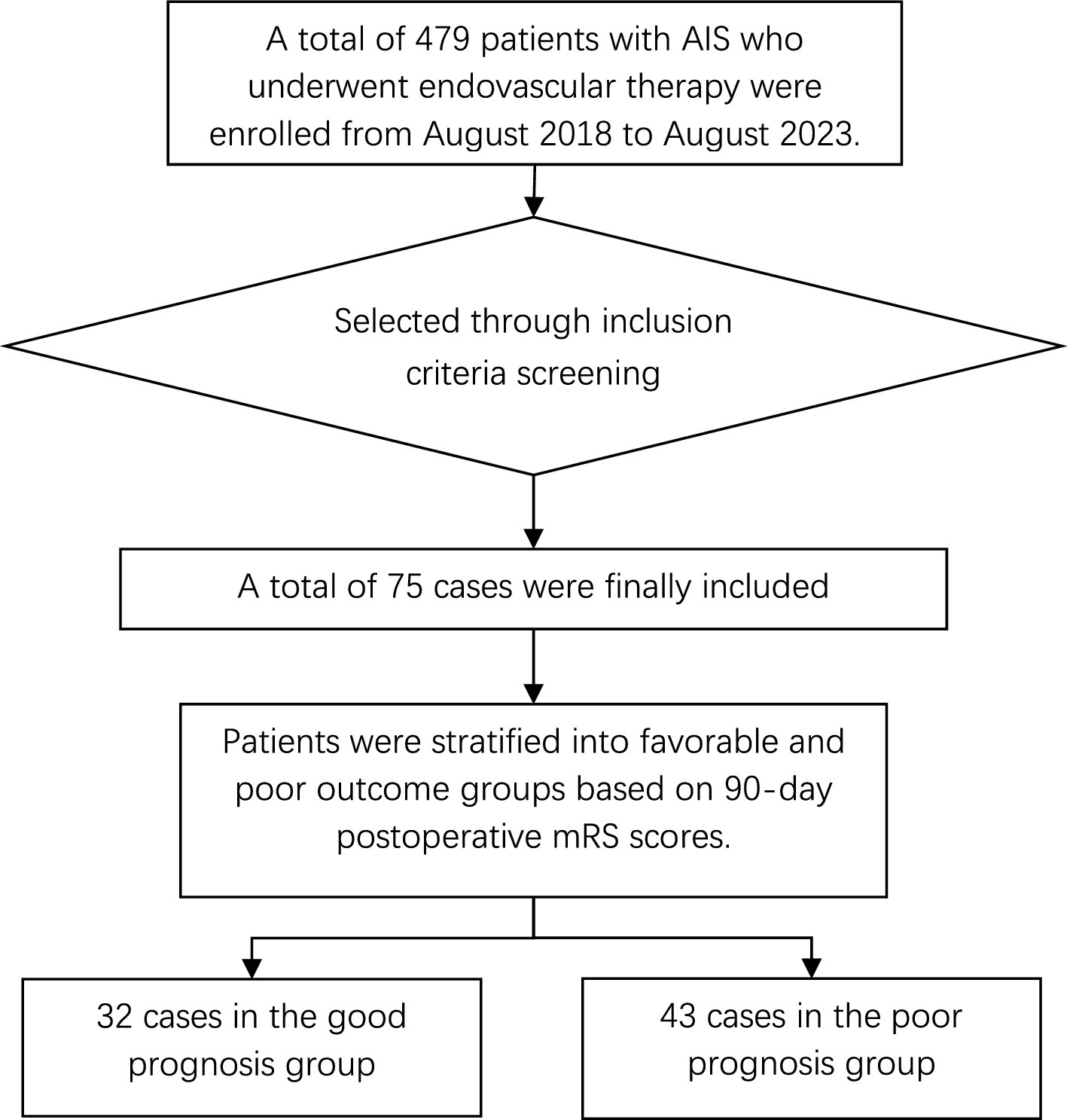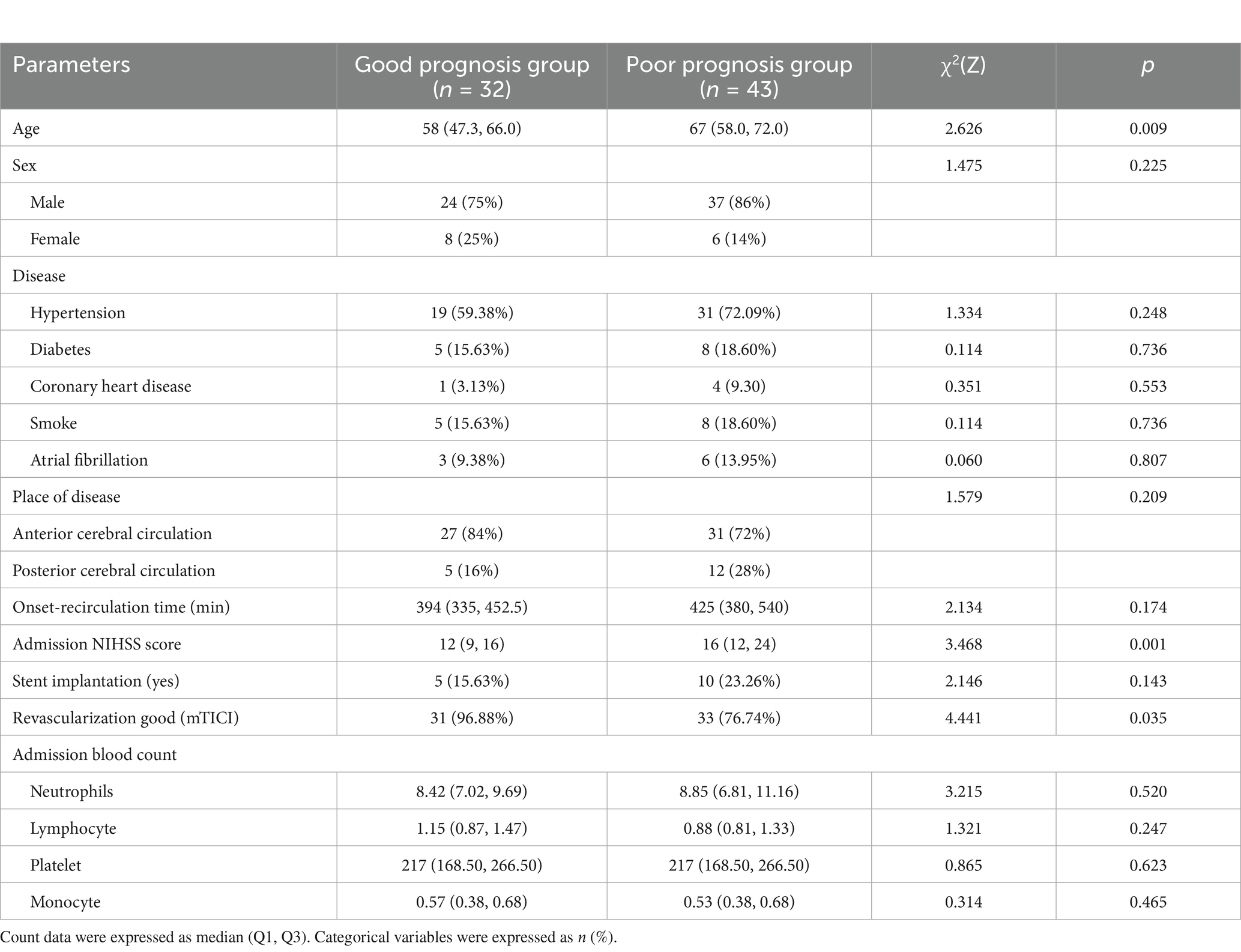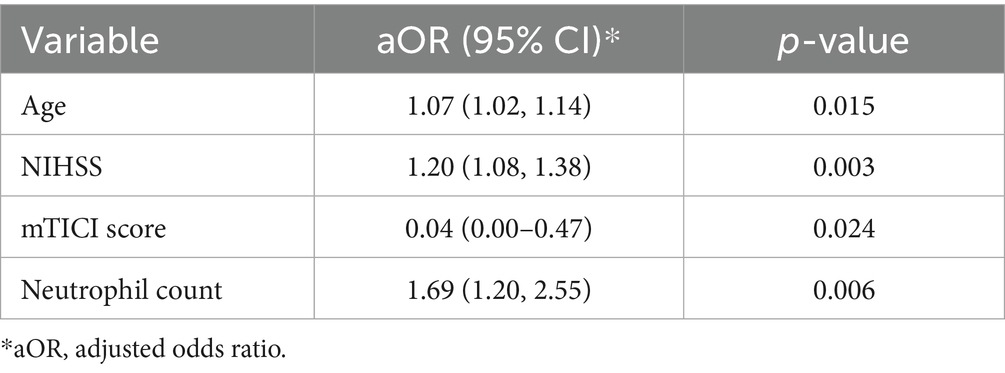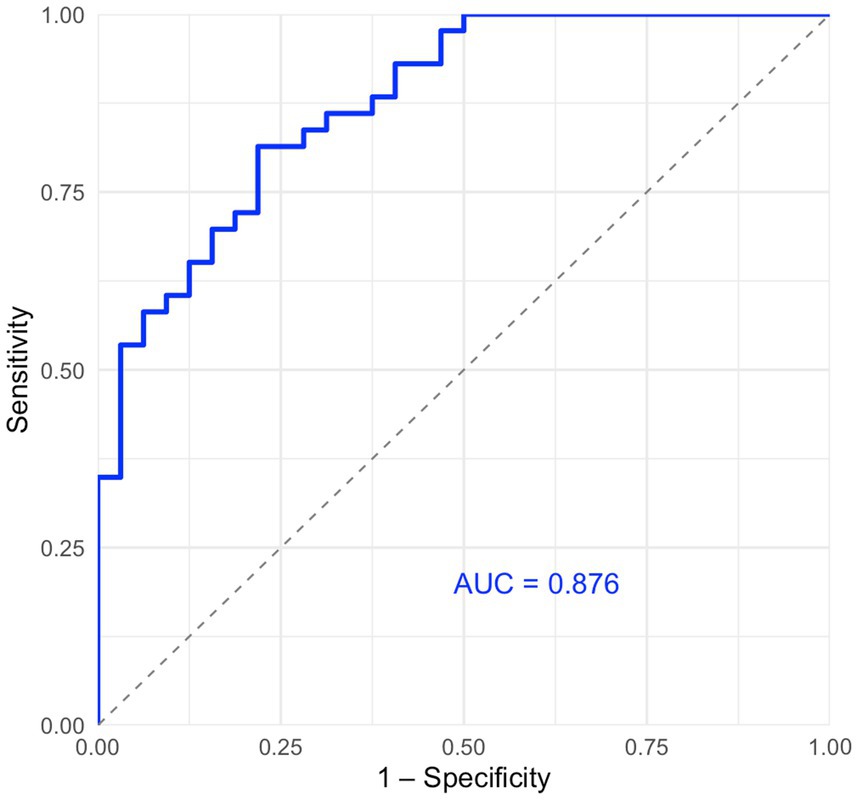- 1The Jiangyin Clinical College of Xuzhou Medical University, Jiangyin, China
- 2Neurosurgery Department, Jiangyin People’s Hospital, Jiangyin, China
Aims/background: In China, the incidence of acute ischemic stroke (AIS) has been rising annually, accounting for 60–70% of all stroke cases. To explore the risk factors leading to poor prognosis after endovascular treatment in patients with acute ischemic stroke tandem lesions after endovascular treatment.
Methods: A retrospective analysis was conducted on the clinical data of patients with tandem lesions who underwent endovascular therapy at Jiangyin People’s Hospital affiliated with Xuzhou Medical University, from July 2018 to August 2023. Post-treatment revascularization was assessed using the modified Thrombolysis in Cerebral Infarction (mTICI) grading system, with grades 3 and 2b indicating good recanalization and grades 2a and below indicating poor recanalization. Patient prognosis at 90 days post-procedure was evaluated using the modified Rankin Scale (mRS), with scores of 0–2 classified as good prognosis and 3–6 as poor prognosis. The age, admission National Institutes of Health Stroke Scale score (NIHSS), gender, hypertension, diabetes mellitus, coronary artery disease, smoking, atrial fibrillation, carotid artery stenting, revascularization, site of tandem lesion (anterior or posterior circulation), and onset-recanalization time (minutes) of the enrolled patients were subjected to univariate analysis. Univariate analysis was performed, followed by multivariate logistic regression for variables with p < 0.1.
Results: A total of 75 patients were included, of whom 32 had good 90-day outcomes and 43 had poor outcomes. Compared to the good outcome group, patients with poor outcomes were older, had higher NIHSS scores at admission, and were less likely to achieve good recanalization (all p < 0.05). Multivariate analysis identified older age, higher NIHSS score, and poor recanalization as independent predictors of poor prognosis. The area under the ROC curve for the NIHSS score was 0.735 (p = 0.001), indicating moderate predictive value.
Conclusion: Advanced age, elevated NIHSS score on admission, and suboptimal recanalization are independently associated with poor 90-day outcomes following endovascular treatment for tandem lesions. The NIHSS score may aid in early risk stratification.
Introduction
Acute ischemic stroke (AIS) is a leading cause of mortality and long-term disability, and its incidence continues to rise in China as the population ages. It now accounts for approximately 80% of all stroke cases nationally (1). Among patients with large vessel occlusion (LVO), approximately 10 to 20% present with tandem lesions (TLs), which involve both extracranial internal carotid artery stenosis or occlusion and simultaneous intracranial arterial occlusion (2). These patients are often more critically ill, require more complex procedures, and face a higher risk of poor functional outcomes compared to those with isolated LVO.
Endovascular therapy (EVT) has become the standard treatment for LVO strokes, and its use in TLs has expanded over the past decade. Several studies suggest that EVT is safe and effective in selected TL cases, particularly those involving the anterior circulation (3). However, some past studies have shown comparable reperfusion outcomes for anterior circulation TLs when mechanical thrombectomy is combined with emergent carotid artery stenting (1, 4). Thus, EVT for TLs remains classified as Class IIa, Level B evidence in current guidelines, reflecting ongoing uncertainty and variability in clinical practice.
This study aimed to evaluate clinical predictors of 90-day functional outcome in patients with AIS due to tandem lesions treated with EVT. Specifically, we examined the association between age, admission NIHSS score, and angiographic reperfusion status and post-treatment prognosis in a real-world cohort that included both anterior and posterior circulation TLs.
Methods
Study population
We conducted a retrospective analysis of consecutive patients with acute TLs who underwent endovascular treatment at Jiangyin People’s Hospital, affiliated with Xuzhou Medical University, between August 2018 and August 2023. All cases were reviewed according to a predefined eligibility framework based on national diagnostic criteria and contemporary clinical practice guidelines.
Patients were eligible for inclusion: (1) first-ever acute ischemic stroke (AIS) patients meeting diagnostic criteria per the Chinese Guidelines for Diagnosis and Treatment of Acute Ischemic Stroke 2019; (2) onset-to-puncture (OTP) time ≤24 h; (3) absence of intracranial hemorrhage confirmed by initial cranial computed tomography (CT) and, where applicable, supplementary imaging; (4) confirmed extracranial carotid pathology (complete occlusion or severe stenosis) with concurrent intracranial arterial occlusion by CT angiography (CTA), MR angiography (MRA), or digital subtraction angiography (DSA); (5) all patients receiving endovascular therapy (EVT), including mechanical thrombectomy (MT) or stent placement; (6) age ≥18 years; (7) National Institutes of Health Stroke Scale (NIHSS) score ≥6; (8) signed informed consent from patients/legal representatives with complete clinical documentation.
Patients with following were excluded from the study: (1) OTP ≥ 24 h or wake-up stroke with potential OTP > 24 h; (2) pre-stroke modified Rankin Scale (mRS) > 2, or history of cerebral infarction/hemorrhage; (3) concurrent major organ failure (cardiac/hepatic/renal); (4) active malignancy or neoplastic disease; (5) non-adherence to prescribed medications, incomplete rehabilitation, or recurrent cerebral infarction within 90 days post-discharge.
This study was conducted under the principles of the Declaration of Helsinki. Ethical approval was obtained from Jiangyin People’s Hospital. Written informed consent was obtained from all participants before the study (Ethical Review Number: JYPH-EC-2022-045). This study was approved by the Ethics Committee of Jiangyin Clinical College of Xuzhou Medical University (2015–021), and all participants provided informed consent.
Endovascular treatment
The endovascular management of cerebrovascular tandem lesions typically follows these standardized steps: (1) Vascular access establishment: Percutaneous femoral artery puncture is performed, followed by sheath insertion and guide catheter navigation to the proximal segment of the target lesion. (2) Priority intracranial revascularization: Mechanical thrombectomy (e.g., stent retriever) or aspiration catheter is employed to remove intracranial thrombi, achieving successful blood flow restoration (mTICI ≥ 2b). (3) Extracranial lesion management: Balloon angioplasty is conducted for extracranial stenosis/occlusion (e.g., carotid artery), with stent implantation if required. Intraprocedural tirofiban (a glycoprotein IIb/IIIa inhibitor) is administered to prevent acute thrombosis. (4) Postoperative management: Blood pressure is tightly controlled (systolic <140 mmHg), and dual antiplatelet therapy (aspirin + clopidogrel) is initiated. Cranial CT is repeated within 24 h to exclude hemorrhage.
Data collection
Baseline demographic and clinical data were retrospectively collected from the medical records of all eligible patients. Variables included age, sex, smoking status, history of hypertension, diabetes mellitus, coronary artery disease, and atrial fibrillation. Procedural and radiological data included lesion location (classified as anterior or posterior circulation), admission National Institutes of Health Stroke Scale (NIHSS) score, onset-to-recanalization time, recanalization success based on modified Thrombolysis in Cerebral Infarction (mTICI) grading (5), and whether carotid stenting was performed. Functional outcome at 90 days was assessed using the modified Rankin Scale (mRS) (6). A good prognosis was defined as an mRS score of 0–2, while a poor prognosis was defined as an mRS score of 3–6. Recanalization was classified as good (mTICI ≥ 2b) or poor (mTICI ≤ 2a).
Statistical analysis
Continuous variables are expressed as mean (SD) in the case of normal distribution or medians (interquartile range) otherwise. Categorical variables are expressed as n (%). Normality of distributions was assessed using the Shapiro–Wilk test. Group differences evaluated using the chi-square test for the categorical variables and Mann–Whitney U-test for the continuous variables.
Univariable analyses were used to identify factors potentially associated with poor functional outcome at 90 days, defined as mRS scores of 3 to 6. For univariable logistic regression analyses, we adjusted for multiple comparisons using the Benjamini–Hochberg procedure to control the false discovery rate. Variables with a p-value less than 0.1 or deemed clinically relevant were entered into a multivariable logistic regression model to identify independent predictors. Model stability was considered by limiting the number of predictors relative to the outcome events. Adjusted odds ratios (aOR) and 95% confidence intervals (CI) were reported for each covariate. Model performance was further evaluated using receiver operating characteristic (ROC) curve analysis, and the area under the curve (AUC) was calculated to assess discriminative capacity. Complete case analysis was performed, as the primary outcome had no missing data. All statistical tests were two-sided, and a p-value < 0.05 was considered statistically significant. Analyses were conducted using SPSS version 26.0 (IBM Corp, Armonk, NY, United States).
Results
Among the 75 patients included in the study (Figure 1), the median age was 62 years (IQR: 53–70), and 81.3% (n = 61) were male. As shown in Table 1, patients with poor functional outcomes at 90 days (mRS 3–6) were older (median age 67 vs. 58 years; p = 0.009) and had more severe neurological deficits at admission (median NIHSS 16 vs. 12; p = 0.001) compared to those with good outcomes. Although distributions of hypertension, diabetes, coronary artery disease, smoking, atrial fibrillation, and lesion location (anterior vs. posterior circulation) were similar between groups, successful recanalization was less frequent in the poor outcome group [33 of 43 (76.7%) vs. of 32 (96.9%); p = 0.035]. Other variables, including stent placement and admission blood count parameters, did not differ significantly between outcome groups. Age, NIHSS score, and onset-recanalization time did not follow a normal distribution [Shapiro–Wilk = 0.953, 0.940, 0.895; p = 0.028, 0.008, 0.001 < 0.05].
Count data were expressed as median (Q1, Q3). Categorical variables were expressed as n (%).
In the multivariable logistic regression (Table 2), older age (OR 1.07, 95% CI 1.02–1.14, p = 0.015), higher admission NIHSS score (OR 1.20, 95% CI 1.08–1.38, p = 0.003), poor recanalization status (OR 0.04, 95% CI 0.00–0.47, p = 0.024), and higher neutrophil count (OR 1.69, 95% CI 1.20–2.55, p = 0.006) were independently associated with poor 90-day outcomes. Univariable associations are presented in Supplementary Table S1. After applying the Benjamini–Hochberg correction (Supplementary Table S1), only the NIHSS score remained statistically significant (adjusted p = 0.032). Age (adjusted p = 0.069) and neutrophil count (adjusted p = 0.056) showed trends toward significance.
ROC curves were plotted in Figure 2. The model, incorporating age, admission NIHSS score, mTICI grade, and neutrophil count, demonstrated good predictive accuracy for poor functional outcomes at 90 days, with an area under the curve of 0.876.
Discussion
This study investigated clinical factors associated with poor 90-day outcomes among patients with acute ischemic stroke due to tandem lesions undergoing endovascular treatment. We found that older age, higher baseline NIHSS score, poor recanalization (as measured by mTICI), and elevated neutrophil counts were significantly associated with poor functional outcomes.
This study demonstrated that advanced age is an independent risk factor for poor prognosis in patients. As age increases, patients exhibit reduced tolerance to surgical interventions, prolonged postoperative recovery times, and a higher incidence of complications, all of which negatively impact clinical outcomes (7). Similarly, the baseline NIHSS score, which reflects initial stroke severity, demonstrated strong predictive value. This is consistent with previous research that has established a clear association between higher admission NIHSS scores and long-term disability in ischemic stroke (8). This study reveals the possibility that systemic inflammation, particularly inflammation reflected by elevated neutrophil counts, is an important factor influencing stroke prognosis (9–12). This finding suggests that inflammatory responses may lead to secondary brain injury or impair microvascular reperfusion. Recent literature has emphasized the role of neutrophil-mediated injury in exacerbating ischemic injury and limiting the effectiveness of revascularization therapy in acute stroke patients (13).
Our finding that vascular recanalization status is a critical determinant of prognosis in patients with TLs is consistent with previous studies (14, 15). In this study, the overall successful recanalization rate was 80% (60/75). Among those with successful recanalization, nearly half of the patients achieved a favorable functional outcome, while the majority of patients with poor recanalization remained functionally dependent. These observations align with the consensus in recent studies suggesting that prompt and effective restoration of cerebral blood flow is critical for recovery (16). Despite the consensus on the benefits of recanalization, the optimal procedural strategy for tandem occlusions remains a subject of ongoing debate (17). For example, Cohen et al. (18) reported that for posterior circulation tandem lesions, prioritizing the opening of distal occlusions through non-occluded pathways is a preferred approach. Another method involves addressing the distal occlusion first, followed by the proximal lesion (19). Each approach has inherent advantages and limitations. The proximal-to-distal strategy allows for early stabilization of access and reduces the risk of distal embolization but may delay intracranial reperfusion, potentially leading to larger infarct volumes. In contrast, the distal-to-proximal method facilitates faster reperfusion of critical intracranial vessels and may limit ischemic injury, but is technically demanding and can increase the risk of complications during proximal stenting or balloon angioplasty. In our institution, the distal-to-proximal approach, prioritizing the opening of distal occlusions to promptly improve distal blood flow and reduce infarct size, was applied more. The specific surgical strategy should be tailored to individual patient characteristics to optimize therapeutic outcomes.
①DSA imaging shows occlusion of the left common carotid artery (LCCA)② LCCA orthotopic contrast ③ Stent positioning after performing LCCA balloon dilatation ④LCCA contrast after 7 × 40 stent release ⑤ Occlusion of the M1 segment of the middle cerebral artery was seen on intracranial imaging ⑥M1 image⑦ Lateral M1image⑧ Microcatheter passes through M1 segment after M2 imaging shows patency after M2 segment ⑨. Final image after removing the thrombosis (Figure 3).
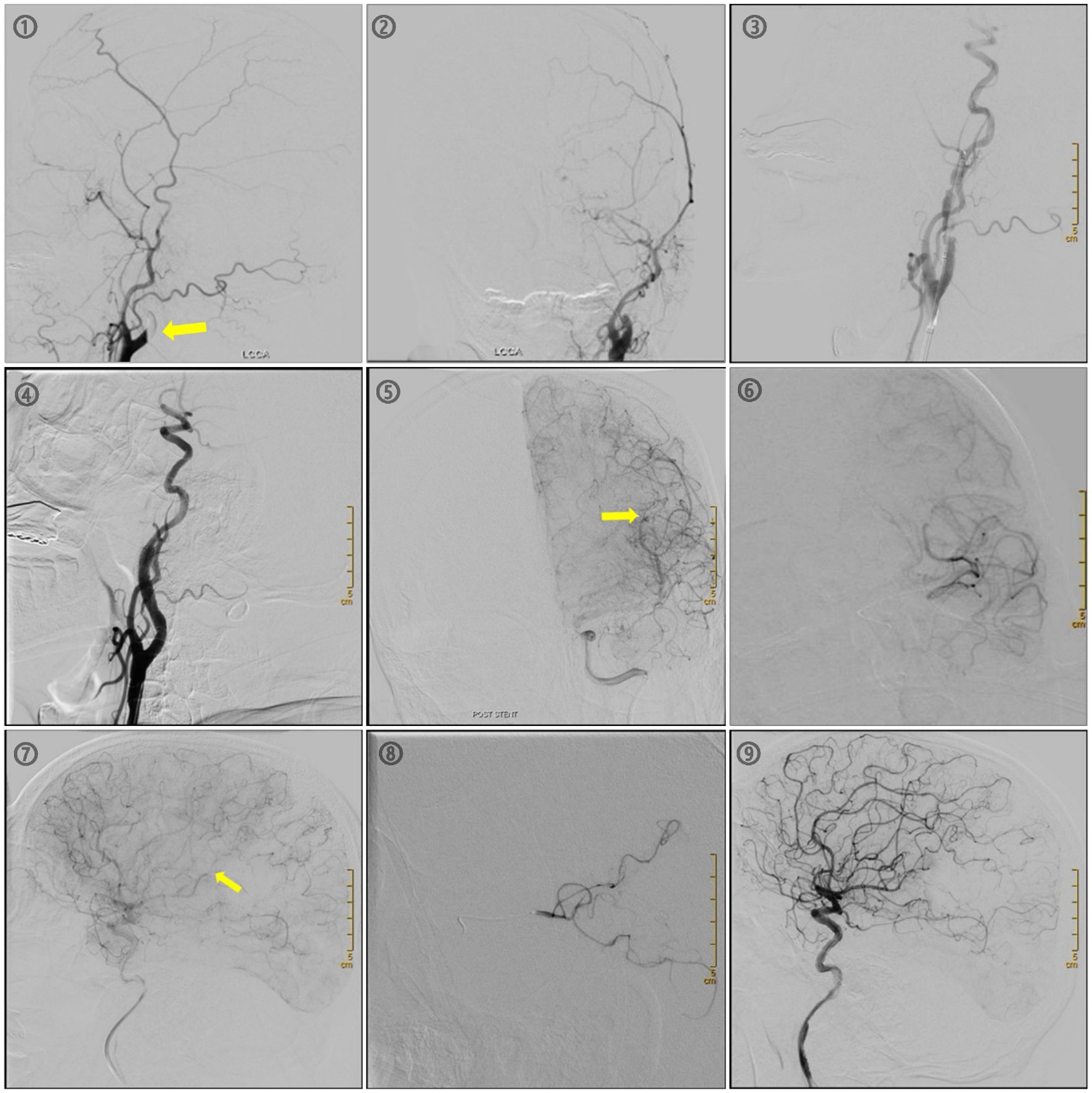
Figure 3. Therapeutic images of a patient treated with endovascular therapy for a tandem lesion of the left common carotid and the M1 of middle cerebral artery.
Tandem lesions often involve atherosclerotic narrowing or occlusion of the extracranial internal carotid artery, making stent implantation a frequent necessity. The decision to place a stent in the acute setting introduces important therapeutic challenges, especially regarding the use of antiplatelet therapy. To prevent in-stent thrombosis, early administration of antiplatelet agents is typically required. However, this practice raises safety concerns, particularly in patients with large infarcts or a high risk of hemorrhagic transformation. Some studies reported that among patients with tandem lesions treated with stent implantation, early anticoagulation with tirofiban showed increased the likelihood of rapid recanalization (20–22). Another study further showed that low-dose micro pumping of tirofiban after endovascular therapy improves the prognosis of patients with TLs without increasing the risk of symptomatic intracranial hemorrhage (23). In our cohort, 15 patients received tirofiban infusion following stent placement. Although the sample size was limited, a substantial proportion of these patients achieved good functional outcomes, which is consistent with previously published findings.
In this study, lesion location, whether in the anterior or posterior circulation, was not significantly associated with 90-day functional outcomes. However, existing literature suggests that posterior circulation tandem lesions (with a favorable prognosis rate of 29.41%, 5/17) are more severe and associated with poorer outcomes compared to anterior circulation tandem lesions (favorable prognosis rate of 46.55%, 27/58). Several anatomical and physiological factors may account for this trend. The posterior cerebral circulation benefits from a network of robust collateral pathways, including connections between the posterior cerebral artery, middle cerebral artery, and anterior cerebral artery through leptomeningeal anastomoses, along with the posterior communicating arteries that form part of the Circle of Willis. These collateral routes can help sustain perfusion during proximal arterial occlusion, delay the progression of ischemic injury, and potentially extend the therapeutic window for intervention. In contrast, anterior circulation tandem lesions, particularly those involving extracranial internal carotid artery occlusion, often lack extensive collateral support before the vessel enters the cranial cavity. This anatomical limitation renders the affected territory more dependent on rapid and complete revascularization to prevent irreversible ischemic damage (24–27). Our study suggested that incomplete recanalization might independently associated with poor outcomes regardless of lesion location. This supports the conclusion that timely and successful reperfusion remains a central determinant of prognosis in patients with tandem lesions. Endovascular therapy, by improving recanalization rates, continues to represent an effective and essential strategy for managing this high-risk population (28, 29, 30).
Several limitations should be acknowledged. First, the study was retrospective and conducted at a single center, which may introduce selection bias and limit the generalizability of the results. Second, the sample size was relatively small, with only 75 patients included, and a particularly low number of cases involving posterior circulation tandem lesions, reflecting the rarity and lower intervention rates in this subgroup. Third, external validation was not performed, and the lack of a prospective design limits the ability to infer causality. Finally, some relevant clinical or imaging factors—such as infarct core volume or collateral status—were not available and may further inform outcome stratification. Future prospective, multicenter studies with larger and more diverse cohorts are needed to validate these associations, improve the robustness of the evidence, and refine risk stratification in this complex stroke population.
In summary, older age, higher admission NIHSS scores, and poor recanalization were independently associated with unfavorable outcomes following endovascular treatment in patients with acute ischemic stroke due to tandem lesions. Among these factors, the NIHSS score on admission demonstrated strong discriminative value, although its sensitivity was suboptimal despite good specificity at a threshold of 18. These findings highlight the clinical importance of initial stroke severity and successful reperfusion in shaping post-treatment outcomes.
Data availability statement
The raw data supporting the conclusions of this article will be made available by the authors, without undue reservation.
Ethics statement
The studies involving humans were approved by the Medical Ethics Committee of Jiangyin People’s Hospital (Approval number: 2025-KY060-01). The studies were conducted in accordance with the local legislation and institutional requirements. Written informed consent for participation was not required from the participants or the participants’ legal guardians/next of kin in accordance with the national legislation and institutional requirements.
Author contributions
ZY: Investigation, Data curation, Writing – original draft, Writing – review & editing. ZX: Writing – review & editing, Methodology, Supervision. CC: Writing – original draft, Writing – review & editing. HX: Writing – original draft, Writing – review & editing.
Funding
The author(s) declare that no financial support was received for the research and/or publication of this article.
Conflict of interest
The authors declare that the research was conducted in the absence of any commercial or financial relationships that could be construed as a potential conflict of interest.
Generative AI statement
The authors declare that no Gen AI was used in the creation of this manuscript.
Any alternative text (alt text) provided alongside figures in this article has been generated by Frontiers with the support of artificial intelligence and reasonable efforts have been made to ensure accuracy, including review by the authors wherever possible. If you identify any issues, please contact us.
Publisher’s note
All claims expressed in this article are solely those of the authors and do not necessarily represent those of their affiliated organizations, or those of the publisher, the editors and the reviewers. Any product that may be evaluated in this article, or claim that may be made by its manufacturer, is not guaranteed or endorsed by the publisher.
Supplementary material
The Supplementary material for this article can be found online at: https://www.frontiersin.org/articles/10.3389/fneur.2025.1628374/full#supplementary-material
References
1. Anadani, M, Marnat, G, Consoli, A, Papanagiotou, P, Nogueira, RG, Siddiqui, A, et al. Endovascular therapy of anterior circulation tandem occlusions. Stroke. (2021) 52:3097–105. doi: 10.1161/strokeaha.120.033032
2. Mahmoud, MN, Zaitoun, MMA, and Abdalla, MA. Revascularization of vertebrobasilar tandem occlusions: a meta-analysis. Neuroradiology. (2021) 64:637–45. doi: 10.1007/s00234-021-02866-w
3. Liu, C-F, Xiao, G, Huang, Z, Xu, Y, You, S, Guo, Z, et al. Effects of different etiologies of anterior circulation tandem lesions on short-term prognosis of acute ischemic stroke. Curr Neurovasc Res. (2023) 20:70–5. doi: 10.2174/1567202620666230201121411
4. Wilson, MP, Murad, MH, Krings, T, Pereira, VM, O’Kelly, C, Rempel, J, et al. Management of tandem occlusions in acute ischemic stroke – intracranial versus extracranial first and extracranial stenting versus angioplasty alone: a systematic review and meta-analysis. J Neurointerventional Surg. (2018) 10:721–8. doi: 10.1136/neurintsurg-2017-013707
5. Zaidat, OO, Yoo, AJ, Khatri, P, Tomsick, TA, von Kummer, R, Saver, JL, et al. Recommendations on angiographic revascularization grading standards for acute ischemic stroke. Stroke. (2013) 44:2650–63. doi: 10.1161/STROKEAHA.113.001972
6. Banks, JL, and Marotta, CA. Outcomes validity and reliability of the modified Rankin scale: implications for stroke clinical trials. Stroke. (2007) 38:1091–6. doi: 10.1161/01.STR.0000258355.23810.c6
7. Kauffmann, J, Grun, D, Yilmaz, U, Wagenpfeil, G, Fassbender, K, Fousse, M, et al. Acute stroke treatment and outcome in the oldest old (90 years and older) at a tertiary care medical Centre in Germany-a retrospective study showing safety and efficacy in this particular patient population. BMC Geriatr. (2021) 21:611. doi: 10.1186/s12877-021-02566-3
8. Adams, HP Jr, Davis, PH, Leira, EC, Chang, KC, Bendixen, BH, Clarke, WR, et al. Baseline NIH stroke scale score strongly predicts outcome after stroke: a report of the trial of org 10172 in acute stroke treatment (TOAST). Neurology. (1999) 53:126–31.
9. Liu, H, Xue, H, Guo, Q, Xue, X, Yang, L, Zhao, K, et al. Ferroptosis meets inflammation: a new frontier in cancer therapy. Cancer Lett. (2025) 620:217696. doi: 10.1016/j.canlet.2025.217696
10. Guo, Q, Zhong, X, Dang, Z, Zhang, B, and Yang, Z. Identification of GBN5 as a molecular biomarker of pan-cancer species by integrated multi-omics analysis. Discov Oncol. (2025) 16:85. doi: 10.1007/s12672-025-01840-9
11. Ke, H, Zhang, Z, Yu, Z, Zhang, B, Chen, R, Zhou, Q, et al. Characteristics of adverse reactions of three anti-glioma drugs in WHO-VigiAccess. Front Pharmacol. (2024) 15:1485067. doi: 10.3389/fphar.2024.1485067
12. Guo, Q, Dong, D, Zhou, Q, Huang, S, Qiao, X, Dang, Z, et al. The association between cardiovascular health and obstructive sleep apnea symptoms: findings from NHANES. Front Cardiovasc Med. (2024) 11:1466752. doi: 10.3389/fcvm.2024.1466752
13. Kang, L, Yu, H, Yang, X, Zhu, Y, Bai, X, Wang, R, et al. Neutrophil extracellular traps released by neutrophils impair revascularization and vascular remodeling after stroke. Nat Commun. (2020) 11:2488. doi: 10.1038/s41467-020-16191-y
14. Rodriguez Calienes, A, Galecio-Castillo, M, Petersen, NH, Ribo, M, Farooqui, M, Hassan, AE, et al. Mediation analysis of acute carotid stenting in tandem lesions: effect on functional outcome in a multicenter registry. Neurology. (2024) 103:e209617. doi: 10.1212/WNL.0000000000209617
15. Saver, JL, Goyal, M, van der Lugt, A, Menon, BK, Majoie, CB, Dippel, DW, et al. Time to treatment with endovascular thrombectomy and outcomes from ischemic stroke: a meta-analysis. JAMA. (2016) 316:1279–88. doi: 10.1001/jama.2016.13647
16. Sanak, D, Kocher, M, Zapletalova, J, Cihlar, F, Czerny, D, Cernik, D, et al. Endovascular treatment for acute ischemic stroke in patients with tandem lesion in the anterior circulation: analysis from the METRICS study. J Neurointerv Surg. (2022) 15:e123–8. doi: 10.1136/jnis-2022-019176
17. Malik, AM, Vora, NA, Lin, R, Zaidi, SF, Aleu, A, Jankowitz, BT, et al. Endovascular treatment of tandem extracranial/intracranial anterior circulation occlusions: preliminary single-center experience. Stroke. (2011) 42:1653–7. doi: 10.1161/STROKEAHA.110.595520
18. Zevallos, CB, Farooqui, M, Quispe-Orozco, D, Mendez-Ruiz, A, Dajles, A, Garg, A, et al. Acute carotid artery stenting versus balloon angioplasty for tandem occlusions: a systematic review and Meta-analysis. J Am Heart Assoc. (2022) 11:e022335. doi: 10.1161/JAHA.121.022335
19. Marnat, G, Buhlmann, M, Eker, OF, Gralla, J, Machi, P, Fischer, U, et al. Multicentric experience in distal-to-proximal revascularization of tandem occlusion stroke related to internal carotid artery dissection. AJNR Am J Neuroradiol. (2018) 39:1093–9. doi: 10.3174/ajnr.A5640
20. Pop, R, Burel, J, Finitsis, SN, Papagiannaki, C, Severac, F, Mangin, PH, et al. Comparison of three antithrombotic strategies for emergent carotid stenting during stroke thrombectomy: a multicenter study. J Neurointerventional Surg. (2023) 15:e388–95. doi: 10.1136/jnis-2022-019875
21. Lin, L, Liu, F, Yi, T, Zhu, Y, Yang, J, Zhao, Y, et al. Tirofiban on first-pass recanalization in acute stroke endovascular Thrombectomy: the OPTIMISTIC randomized clinical trial. JAMA Netw Open. (2025) 8:e255308. doi: 10.1001/jamanetworkopen.2025.5308
22. Investigators, RBT, Qiu, Z, Li, F, Sang, H, Luo, W, Liu, S, et al. Effect of intravenous tirofiban vs placebo before endovascular thrombectomy on functional outcomes in large vessel occlusion stroke: the RESCUE BT randomized clinical trial. JAMA. (2022) 328:543–53.
23. Yogendrakumar, V, Churilov, L, Mitchell, PJ, Kleinig, TJ, Yassi, N, Thijs, V, et al. Safety and efficacy of tenecteplase and alteplase in patients with tandem lesion stroke. Neurology. (2023) 100:e1900–e1911. doi: 10.1212/WNL.0000000000207138
24. Uniken Venema, SM, Dankbaar, JW, van der Lugt, A, Dippel, DWJ, and van der Worp, HB. Cerebral collateral circulation in the era of reperfusion therapies for acute ischemic stroke. Stroke. (2022) 53:3222–34. doi: 10.1161/STROKEAHA.121.037869
25. Liebeskind, DS. Collateral circulation. Stroke. (2003) 34:2279–84. doi: 10.1161/01.STR.0000086465.41263.06
26. Derdeyn, CP, Shaibani, A, Moran, CJ, Cross, DT 3rd, Grubb, RL Jr, and Powers, WJ. Lack of correlation between pattern of collateralization and misery perfusion in patients with carotid occlusion. Stroke. (1999) 30:1025–32. doi: 10.1161/01.str.30.5.1025
27. Tatelman, M. Pathways of cerebral collateral circulation. Radiology. (1960) 75:349–62. doi: 10.1148/75.3.349
28. Meyer, L, Politi, M, Alexandrou, M, Roth, C, Kastrup, A, Mpotsaris, A, et al. Endovascular treatment of acute tandem lesions in patients with mild anterior circulation stroke. J Neurointerventional Surg. (2023) 15:e136–41. doi: 10.1136/jnis-2022-019239
29. Zapata-Arriaza, E, Medina-Rodriguez, M, Ortega-Quintanilla, J, De Albóniga-Chindurza, A, Ainz-Gómez, L, Pardo-Galiana, B, et al. Relevance of carotid Reocclusion in tandem lesions. J Atheroscler Thromb. (2023) 30:636–48. doi: 10.5551/jat.63560
30. Farooqui, M, Zaidat, OO, Hassan, AE, Quispe-Orozco, D, Petersen, N, Divani, AA, et al. Functional and safety outcomes of carotid artery stenting and mechanical Thrombectomy for large vessel occlusion ischemic stroke with tandem lesions. JAMA Netw Open. (2023) 6:e230736. doi: 10.1001/jamanetworkopen.2023.0736
Keywords: tandem lesions, endovascular procedures, prognosis, mechanical thrombectomy, acute ischemic stroke
Citation: Zhang Y, Zhou X, Cao C and Huang X (2025) Analysis of risk factors for poor prognosis after endovascular treatment of tandem lesions in acute ischemic stroke. Front. Neurol. 16:1628374. doi: 10.3389/fneur.2025.1628374
Edited by:
Xintian Cai, Sichuan Academy of Medical Sciences and Sichuan Provincial People's Hospital, ChinaReviewed by:
Qian Guo, First Affiliated Hospital of Zhengzhou University, ChinaXue Yu, Stanford University, United States
Copyright © 2025 Zhang, Zhou, Cao and Huang. This is an open-access article distributed under the terms of the Creative Commons Attribution License (CC BY). The use, distribution or reproduction in other forums is permitted, provided the original author(s) and the copyright owner(s) are credited and that the original publication in this journal is cited, in accordance with accepted academic practice. No use, distribution or reproduction is permitted which does not comply with these terms.
*Correspondence: Yifan Zhang, MTc4NTExODA2ODNAMTYzLmNvbQ==; Xinmin Zhou, enhpbm1pbkBzaW5hLmNvbQ==
 Yifan Zhang
Yifan Zhang Xinmin Zhou
Xinmin Zhou Cheng Cao
Cheng Cao Xin Huang2
Xin Huang2